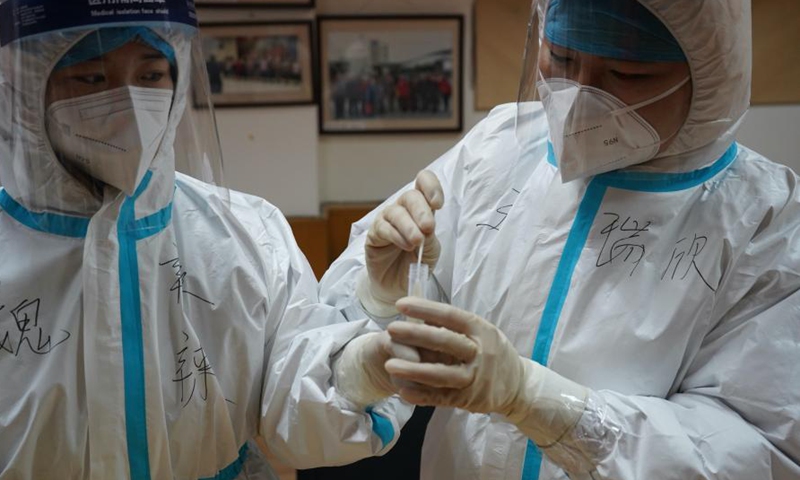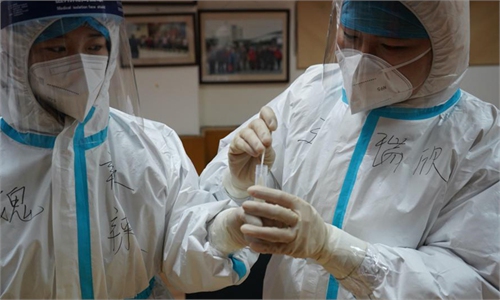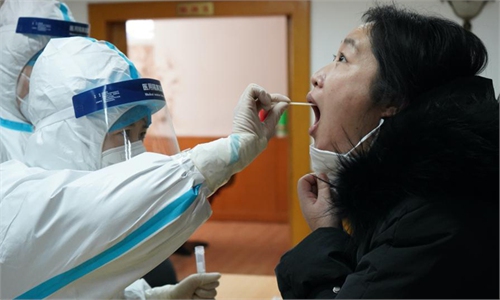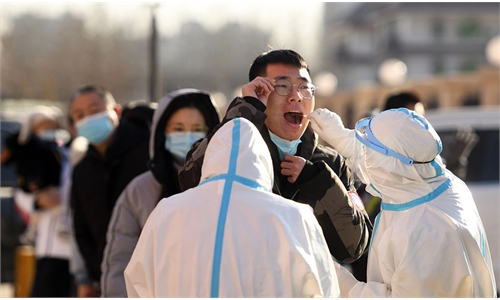
Medical workers seal a sample at a community in Yuhua District of Shijiazhuang, capital of north China's Hebei Province, Jan. 7, 2021. Shijiazhuang started to conduct citywide nucleic acid tests covering all residents on Wednesday. (Xinhua/Jin Haoyuan)
The virus strain found in coronavirus-hit Hebei Province in North China is believed to be from overseas and patient zero had emerged before December 15, Hebei authorities revealed on Sunday, but how the virus was imported remains a mystery.Even though Shijiazhuang reported 40 more confirmed cases in the morning of Sunday, experts predicted that whether this outbreak can be brought under control depends on whether the number of new confirmed cases sees a downward trend in the next two weeks.
The tracking of infection sources is ongoing, but preliminary estimates showed that the virus strain of the Hebei outbreak may have originated from overseas. The virus gene sequencing results showed the virus strain belongs to a European family branch, and has no relation with previous domestic outbreaks, Shi Jian, an official from the Hebei provincial disease prevention and control center, said at a press conference on Sunday.
Furthermore, the full genome sequence of the coronavirus in this outbreak does not contain the mutant viruses detested in Great British and South Africa, Shi revealed.
Based on the time of the onset of the early cases and the passage of the virus, it is initially thought that patient zero had emerged before December 15.
Previously, experts said the Shijiazhuang international airport could have brought the virus into neighboring villages, which is also the epicenter of the current outbreak.
Those infections were distributed to within a few kilometers around the airport, and some of the infections are related to hotels with villagers living nearby, Shi said.
As part of efforts to find the source of infections, local authorities will thoroughly check any quarantined people from overseas and working staff, and airport working staff involved in international cargo loading from November. Cold-chain industry personnel and imported cargo will also be disinfected.
However, local authorities revealed at the Sunday conference that no turning point is in sight in this outbreak and epidemic risks still exist.

A courier in Shijiazhuang, capital of North China's Hebei Province, hands a parcel to a local community guard on Sunday as the city's delivery services resumed after being affected by local mass nucleic acid testing to try to curb the spread of the coronavirus infections in the city. Photo: Xinhua
A total of 364 positive cases were discovered among 13 million residents from Shijiazhuang and Xingtai in Hebei who had undergone nucleic acid tests, authorities announced Sunday, saying the epidemic scale shows no sign of expanding, but more positive infections are likely to be seen in the near future.
These 364 positive infections were found from the cities of Shijiazhuang and Xingtai in the first round of mass nucleic acid testing. The second round of tests is ongoing.
About 87 percent of the positive infections are clustered cases from Gaocheng district in Shijiazhuang. The nucleic acid tests showed that the current infection scale is not expanding, local authorities announced at the press conference on Sunday.
The province is looking for 119 close contacts circulating in 20 other provinces and cities. So far, no positive cases have been found among those close contacts.
The epidemiological investigation into all COVID-19 cases has been completed. More than 11,000 close contacts and 5,800 secondary close contacts have been tracked and quarantined. Another 1.28 million people who were labeled as key population are being closely monitored, Shi revealed.
Wang Guangfa, a respiratory expert at Peking University First Hospital, told the Global Times on Sunday that whether the epidemic in Shijiazhuang can be brought under control depends on how many new infections emerge in the next two weeks. If the prevention and control measures taken by the local government are effective, then ideally, the new confirmed cases will see a downward trend within two weeks.
As patient zero emerged before December 15 and the city continues to find new infections, Wang said this means the virus has been spreading among the population for days and they were not being detected in time, warning of the existence of undiscovered patients.
Zhang Wenhong, a Shanghai-based leading infectious disease specialist, believed the outbreak in Shijiazhuang can be curbed in few weeks or even within one week, as he believes the epidemic in the northern Chinese city is clustered and not widespread.




